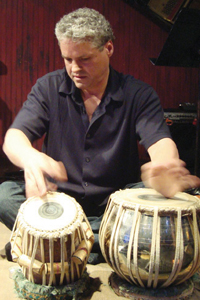"I began my percussion sojourn on drum set, playing jazz, rock, and fusion styles in high school, inspired by Buddy Rich, Keith Moon, and Phil Collins's work with the '70s fusion band Brand X. After discovering Crystal Silence by Gary Burton and Chick Corea, I became a vibes enthusiast. At Berklee I was honored to study vibes with Ed Saindon and Gary Burton. I was also exposed to world percussion: Afro-Cuban hand drums with Pablo Landrum and African music with Godwin Agbeli (ewe) and Dolsi-naa Abubakari Luna (dagomba). After hearing Zakir Hussain with the word fusion band Shakti I delved into classical Indian music. Three decades of exploration have taken me to Africa, India, the Caribbean, the Middle East, and Spain. Studying authentically has allowed me to develop the tools and repertoire to play in traditional settings, while improvisational and arranging skills acquired at Berklee support the creation of new music."
"My teaching method, called 'harmonic time,' places every musician on the same playing field for discovering rhythm as mind-body-spirit immersion. It is based on the African model of drumming, singing, and dance. This three-tiered method involves side-to-side stepping patterns (with ankle bells), counter-sticking/clapping patterns, and vocalization of African and Indian drum languages and songs that help to internalize musical time, groove, and mathematics into the entire body and not just the intellect or hands. Harmonic time allows the musician to 'feel' how patterns interlock and not just 'hear' them. This also allows students to practice away from their primary instrument, to always be thinking about groove and the potential for shifting degrees of focus. Theory becomes practice as African and Indian time layers are logically and musically applied to drum set. Students explore all of the possible ways of playing one idea and be engaged in that idea all of the time ('all ways and always')."
"Living in current competitive conditions, drummers need to develop fundamental skills playing world percussion: congas, frame drums, cajón, or dumbek, for instance. With these added resources, assimilating traditional rhythms to drum set becomes easier and more profound. By focusing on the process of learning music (taking small steps), after years of work you will have traveled a great distance in your own journey. I tell students not to be determined to reach a goal or play like their heroes; rather, be devoted to the love of the art itself."

